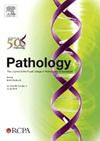Overexpression of fibroblast activation protein (FAP) in the stroma of proliferative inflammatory atrophy (PIA) and primary adenocarcinoma of the prostate
IF 3
3区 医学
Q1 PATHOLOGY
引用次数: 0
Abstract
Fibroblast activation protein (FAP) is a serine protease upregulated at sites of tissue remodelling and cancer that represents a promising therapeutic and molecular imaging target. In prostate cancer, studies of FAP expression using tissue microarrays are conflicting, such that its clinical potential is unclear. Furthermore, little is known regarding FAP expression in benign prostatic tissues. Here we demonstrated, using a novel iterative multiplex immunohistochemistry assay in standard tissue sections, that FAP was nearly absent in normal regions but was increased consistently in regions of proliferative inflammatory atrophy (PIA). In carcinoma, FAP was expressed in all cases but was highly heterogeneous. High FAP levels were associated with increased pathological stage and cribriform morphology. We verified that FAP levels in cancer correlated with CD163+ M2 macrophage density. In this first report to quantify FAP protein in benign prostate and primary tumours, using standard large tissue sections, we clarify that FAP is present in all primary prostatic carcinomas, supporting its potential clinical relevance. The finding of high levels of FAP within PIA supports the injury/regeneration model for its pathogenesis and suggests that it harbours a protumourigenic stroma, yet high levels of FAP in benign regions could lead to false-positive FAP-based molecular imaging results in clinically localised prostate cancer.
增生性炎性萎缩(PIA)和原发性前列腺腺癌间质中成纤维细胞激活蛋白(FAP)的过表达。
成纤维细胞活化蛋白(FAP)是一种丝氨酸蛋白酶,在组织重塑和癌症中表达上调,是一种有前景的治疗和分子成像靶点。在前列腺癌中,使用组织微阵列对FAP表达的研究存在矛盾,因此其临床潜力尚不清楚。此外,对于FAP在良性前列腺组织中的表达了解甚少。在这里,我们在标准组织切片中使用一种新的迭代多重免疫组织化学方法证明,FAP在正常区域几乎不存在,但在增殖性炎症性萎缩(PIA)区域却持续增加。在癌中,FAP在所有病例中均有表达,但具有高度异质性。高FAP水平与病理分期和筛网形态增加有关。我们证实癌症中FAP水平与CD163+ M2巨噬细胞密度相关。在这篇首次量化良性前列腺肿瘤和原发性肿瘤中FAP蛋白的报告中,我们使用标准的大组织切片,阐明FAP存在于所有原发性前列腺癌中,支持其潜在的临床相关性。在PIA中发现高水平的FAP支持其发病机制的损伤/再生模型,并提示其含有产瘤原基质,然而良性区域的高水平FAP可能导致临床局限性前列腺癌中基于FAP的分子成像结果假阳性。
本文章由计算机程序翻译,如有差异,请以英文原文为准。
求助全文
约1分钟内获得全文
求助全文
来源期刊

Pathology
医学-病理学
CiteScore
6.50
自引率
2.20%
发文量
459
审稿时长
54 days
期刊介绍:
Published by Elsevier from 2016
Pathology is the official journal of the Royal College of Pathologists of Australasia (RCPA). It is committed to publishing peer-reviewed, original articles related to the science of pathology in its broadest sense, including anatomical pathology, chemical pathology and biochemistry, cytopathology, experimental pathology, forensic pathology and morbid anatomy, genetics, haematology, immunology and immunopathology, microbiology and molecular pathology.
 求助内容:
求助内容: 应助结果提醒方式:
应助结果提醒方式:


